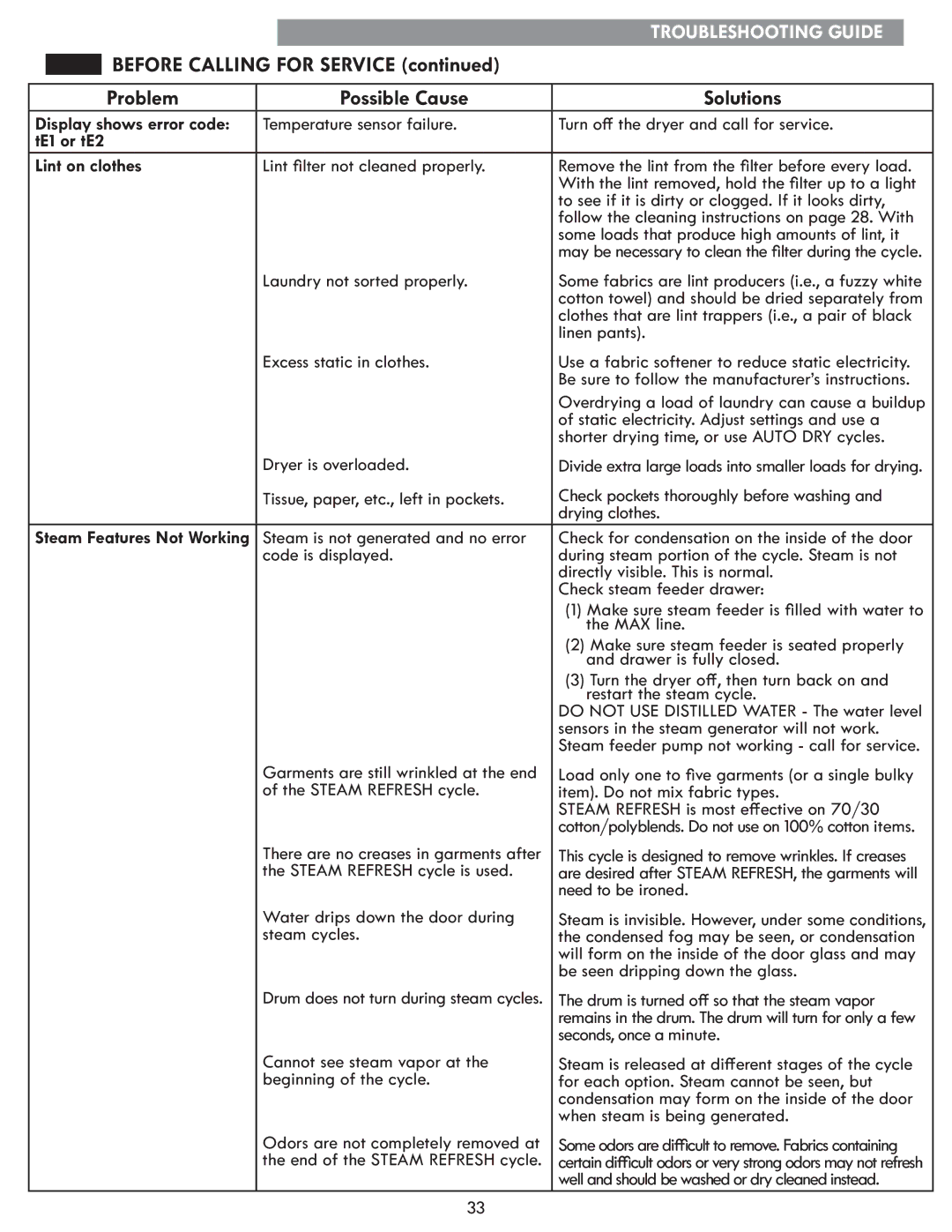|
|
|
|
| TROUBLESHOOTING GUIDE |
|
|
| BEFORE CALLING FOR SERVICE (continued) |
|
| ||
|
|
|
| |||
|
|
|
|
|
| |
|
| Problem |
| Possible Cause | Solutions | |
Display shows error code: | Temperature sensor failure. | Turn off the dryer and call for service. | ||||
tE1 or tE2 |
|
|
|
| ||
Lint on clothes | Lint filter not cleaned properly. | Remove the lint from the filter before every load. | ||||
|
|
|
|
| With the lint removed, hold the filter up to a light | |
|
|
|
|
| to see if it is dirty or clogged. If it looks dirty, | |
|
|
|
|
| follow the cleaning instructions on page 28. With | |
|
|
|
|
| some loads that produce high amounts of lint, it | |
|
|
|
|
| may be necessary to clean the filter during the cycle. | |
|
|
| Laundry not sorted properly. | Some fabrics are lint producers (i.e., a fuzzy white | ||
|
|
|
|
| cotton towel) and should be dried separately from | |
|
|
|
|
| clothes that are lint trappers (i.e., a pair of black | |
|
|
|
|
| linen pants). | |
|
|
| Excess static in clothes. | Use a fabric softener to reduce static electricity. | ||
|
|
|
|
| Be sure to follow the manufacturer’s instructions. | |
|
|
|
|
| Overdrying a load of laundry can cause a buildup | |
|
|
|
|
| of static electricity. Adjust settings and use a | |
|
|
|
|
| shorter drying time, or use AUTO DRY cycles. | |
|
|
| Dryer is overloaded. | Divide extra large loads into smaller loads for drying. | ||
|
|
| Tissue, paper, etc., left in pockets. | Check pockets thoroughly before washing and | ||
|
|
|
|
| drying clothes. | |
Steam Features Not Working | Steam is not generated and no error | Check for condensation on the inside of the door | ||||
|
|
| code is displayed. | during steam portion of the cycle. Steam is not | ||
|
|
|
|
| directly visible. This is normal. | |
|
|
|
|
| Check steam feeder drawer: | |
|
|
|
|
| (1) Make sure steam feeder is filled with water to | |
|
|
|
|
| the MAX line. | |
|
|
|
|
| (2) Make sure steam feeder is seated properly | |
|
|
|
|
| and drawer is fully closed. | |
|
|
|
|
| (3) Turn the dryer off, then turn back on and | |
|
|
|
|
| restart the steam cycle. | |
|
|
|
|
| DO NOT USE DISTILLED WATER - The water level | |
|
|
|
|
| sensors in the steam generator will not work. | |
|
|
|
|
| Steam feeder pump not working - call for service. | |
|
|
| Garments are still wrinkled at the end | Load only one to five garments (or a single bulky | ||
|
|
| of the STEAM REFRESH cycle. | item). Do not mix fabric types. | ||
|
|
|
|
| STEAM REFRESH is most effective on 70/30 | |
|
|
|
|
| cotton/polyblends. Do not use on 100% cotton items. | |
|
|
| There are no creases in garments after | This cycle is designed to remove wrinkles. If creases | ||
|
|
| the STEAM REFRESH cycle is used. | are desired after STEAM REFRESH, the garments will | ||
|
|
|
|
| need to be ironed. | |
|
|
| Water drips down the door during | Steam is invisible. However, under some conditions, | ||
|
|
| steam cycles. | the condensed fog may be seen, or condensation | ||
|
|
|
|
| will form on the inside of the door glass and may | |
|
|
|
|
| be seen dripping down the glass. | |
|
|
| Drum does not turn during steam cycles. | The drum is turned off so that the steam vapor | ||
|
|
|
|
| remains in the drum. The drum will turn for only a few | |
|
|
|
|
| seconds, once a minute. | |
|
|
| Cannot see steam vapor at the | Steam is released at different stages of the cycle | ||
|
|
| beginning of the cycle. | for each option. Steam cannot be seen, but | ||
|
|
|
|
| condensation may form on the inside of the door | |
|
|
|
|
| when steam is being generated. | |
|
|
| Odors are not completely removed at | Some odors are difficult to remove. Fabrics containing | ||
|
|
| the end of the STEAM REFRESH cycle. | certain difficult odors or very strong odors may not refresh | ||
|
|
|
|
| well and should be washed or dry cleaned instead. | |
33
